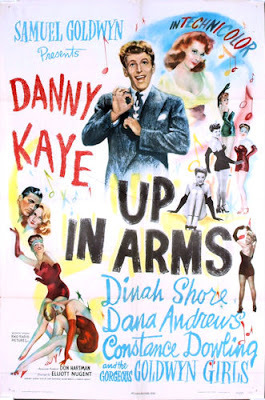"Up in Arms": A Peach of a Pair at the Movies
 When your mother is a packrat, you find yourself with all sorts of treasures. The letters my parents exchanged during World War II, when my G.I. father was stationed in a finance office in Indianapolis while my mother served as a social worker in Omaha, showed how important a role movies played in keeping their morale high during their enforced separation from one another. Both went to the movies constantly in their off-hours: motion pictures were cheap entertainment, could provide inspiration or a few laughs, and had the extra advantage of being shown in theatres that were “refrigerated,” in the terminology of the day. There’s one family story about Omaha, a sweltering city in mid-summer. Given that few residences were air-conditioned, staying home was out of the question. And so my parents—when together--were always seeking out movies that struck their fancy. They loved to laugh, which is why comedies were always their first choice. In the summer of 1944, that meant Danny Kaye in Up in Arms: they saw this laugh-fest about a hypochondriac who gets drafted into the Army at least seven times in the space of a few weeks. As a result, they learned all the musical numbers (including the zany Lobby Number) by heart -- and, years later, so did I. (When it’s cherry blossom time in Orange, New Jersey, we’ll make a peach of a pair . . . . but I digress.)
When your mother is a packrat, you find yourself with all sorts of treasures. The letters my parents exchanged during World War II, when my G.I. father was stationed in a finance office in Indianapolis while my mother served as a social worker in Omaha, showed how important a role movies played in keeping their morale high during their enforced separation from one another. Both went to the movies constantly in their off-hours: motion pictures were cheap entertainment, could provide inspiration or a few laughs, and had the extra advantage of being shown in theatres that were “refrigerated,” in the terminology of the day. There’s one family story about Omaha, a sweltering city in mid-summer. Given that few residences were air-conditioned, staying home was out of the question. And so my parents—when together--were always seeking out movies that struck their fancy. They loved to laugh, which is why comedies were always their first choice. In the summer of 1944, that meant Danny Kaye in Up in Arms: they saw this laugh-fest about a hypochondriac who gets drafted into the Army at least seven times in the space of a few weeks. As a result, they learned all the musical numbers (including the zany Lobby Number) by heart -- and, years later, so did I. (When it’s cherry blossom time in Orange, New Jersey, we’ll make a peach of a pair . . . . but I digress.)Sadly, I’m cleaning out my mother’s home these days. (She died almost a year ago, at age 96.) Among the many souvenirs she saved was a professional caricature of herself done on May 5, 1944, on the back of a menu at L.A.’s swankiest nightspot, the Cocoanut Grove. My parents were obviously celebrating being home on a brief leave by going out on the town. The Cocoanut Grove, located in the famous Ambassador Hotel, was well known for its jungle décor, and for being a playground for Hollywood stars. My folks were Depression-era kids, so the prices must have seemed extravagant. Like the Dinner de Luxe, featuring an appetizer, soup, an entrée like chicken or leg of lamb, salad, dessert, and demi-tasse, for a whopping $3.00. And you also got to see a stage show featuring some of the day’s hottest musical acts.
Needless to say, the Cocoanut Grove was featured in many films. On February 29, 1940, the Academy Awards were staged there, with Bob Hope as emcee. In 1967, the Cocoanut Grove didn’t make it into The Graduate. But the scenes supposedly set in the “Taft Hotel” lobby (where desk clerk Buck Henry flummoxes Benjamin Braddock by asking, “Are you here for an affair, sir?”) were shot in a cordoned-off section of the Ambassador’s own spacious entryway. Just one year later, in the wee hours of June 5, 1968, the Ambassador Hotel found another, much sadder, form of notoriety when Democratic presidential candidate Robert F. Kennedy—having just won the California primary—was gunned down by Sirhan Sirhan. The hotel was Kennedy’s campaign headquarters. Having delivered a victory speech in one ballroom, he was passing through a hotel kitchen on his way to another venue, when Sirhan fired three times at close range. He died following surgery.
It’s eerie to remember that I was there – one of thousands waiting to hear a victory speech that never came. My parents were present too. The Ambassador Hotel seemed far less glamorous after that tragedy. It closed down early in this century, and was replaced with a school complex that bears Kennedy’s name. A planned documentary about the Ambassador never quite happened.
Published on October 13, 2015 09:45
No comments have been added yet.
Beverly in Movieland
I write twice weekly, covering topics relating to movies, moviemaking, and growing up Hollywood-adjacent. I believe that movies can change lives, and I'm always happy to hear from readers who'd like t
I write twice weekly, covering topics relating to movies, moviemaking, and growing up Hollywood-adjacent. I believe that movies can change lives, and I'm always happy to hear from readers who'd like to discuss that point.
...more
- Beverly Gray's profile
- 10 followers



